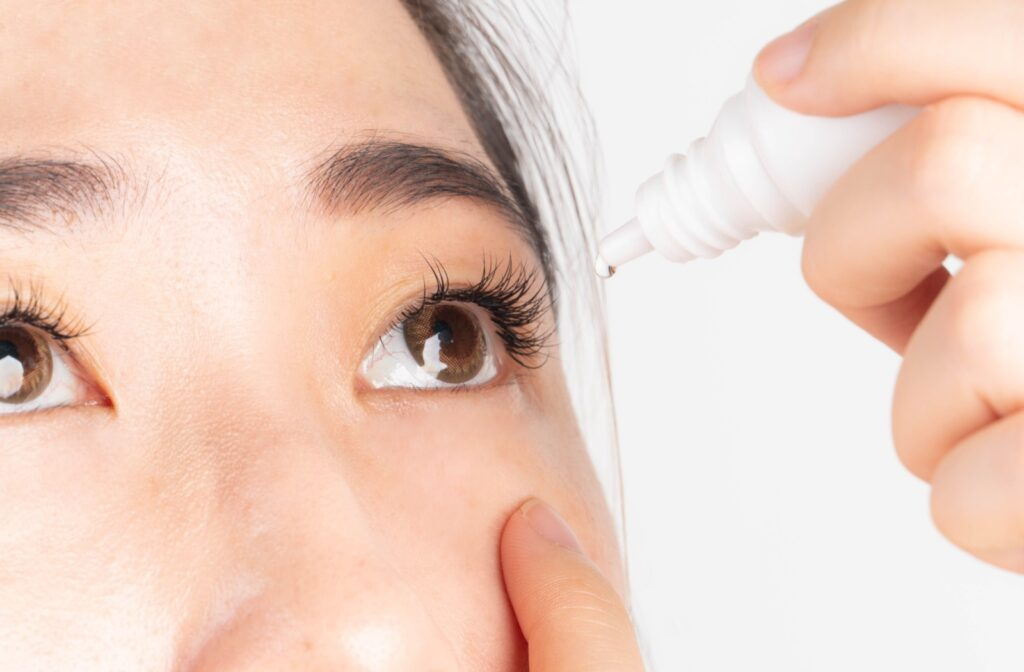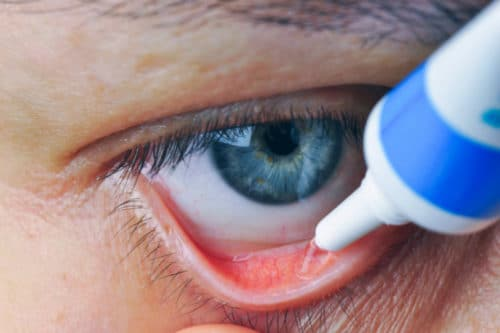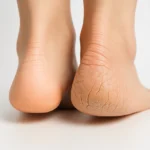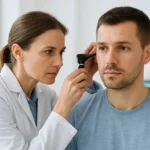
How to Treat Dry Eyes Naturally Without Medication or Drops
- What Dry Eye Syndrome Really Feels Like
- Common Causes I’ve Observed in Dry Eye Clients
- The Stages of Dry Eye Progression and How to Recognize Them
- Why Over-the-Counter Eye Drops Can Make Things Worse
- Natural Ways to Restore the Tear Film Without Chemicals
- Foods That Nourish the Eyes from the Inside Out
- The Hidden Role of Sleep and Light Exposure
- How Low Iron Levels Can Contribute to Dry Eye Syndrome
- When Dry Eyes and Acid Reflux Share the Same Root Cause
- The Emotional Toll of Dry Eyes and How Anxiety Amplifies It
- Natural Oils and Herbal Extracts That Support the Eyes
- Long-Term Consequences of Ignoring Dry Eyes
- Signs That Your Eyes Are Finally Healing
- FAQ – Your Dry Eye Questions Answered

What Dry Eye Syndrome Really Feels Like
It often starts subtly — a scratchy sensation in the morning, tired eyes after reading, or a mysterious discomfort during screen time. Most people assume it’s just fatigue or “normal aging,” but dry eye syndrome has a very specific character that becomes clearer over time.
I’ve heard clients describe it like they’re blinking over sandpaper. Others say their eyes feel strangely wet, then dry — as if the tears don’t stick. What’s happening here is often a disruption in the delicate balance between tear production and tear evaporation. The eyes either don’t produce enough tears, or the tears they do make evaporate too fast to protect the surface.
This condition can vary greatly by time of day, season, indoor air, or emotional state. And it’s not just physical — over time, the irritation and visual fatigue can lead to headaches, frustration, and a surprising amount of emotional exhaustion.
Common Causes I’ve Observed in Dry Eye Clients
While mainstream sources often focus on screens or contact lenses, I’ve learned that dry eyes tend to be multifactorial. Hormonal changes, for example, are a major trigger — especially in women going through pregnancy or early menopause.
Many of the people I’ve worked with also experience chronic dehydration, which isn’t always about water intake. I’ve seen cases where people drink plenty of fluids but consume so much caffeine or salt that their body never truly hydrates.
Environmental irritants are another key factor. Forced-air heating in winter, over-air-conditioned offices, or even daily exposure to traffic pollution can silently dry the eyes. And surprisingly often, systemic health conditions play a role — for instance, when I see dry eyes in combination with fatigue, hair thinning, and brittle nails, I always recommend checking thyroid levels like in what are early signs of hypothyroidism in women

The Stages of Dry Eye Progression and How to Recognize Them
Not everyone with dry eyes experiences them the same way. That’s why I find it helpful to break the condition into progressive stages — this helps you understand what’s happening and how soon you can take natural action to interrupt the cycle.
| Stage | Signs You Might Notice | What’s Happening Internally |
| Mild | Grittiness in the morning, slight redness | Tear film begins thinning; eyes lose moisture slowly |
| Moderate | Fatigue by afternoon, need to blink often | Tear film instability and faster evaporation |
| Advanced | Stinging, light sensitivity, blurry vision | Surface inflammation, possible corneal involvement |
| Chronic & Severe | Inability to wear lenses, pain, insomnia | Damage to eye surface, nerve irritation |
Understanding where you are on this spectrum allows you to choose the right remedy — and to act early, before the damage becomes long-term.
Why Over-the-Counter Eye Drops Can Make Things Worse
One of the most common patterns I’ve seen is the overuse of lubricating eye drops. Most people assume that if your eyes are dry, adding moisture directly should solve the issue. But the truth is, many drops — especially those with preservatives — do more harm than good when used daily.
Artificial tears can wash away your natural tear film, weakening the eye’s natural ability to regulate its moisture layer. Some clients have told me their eyes actually felt drier within an hour of using drops — and that matches what I’ve seen clinically.
It’s not that eye drops are inherently bad. They have their place — especially in the early stages. But using them as a sole treatment creates dependence and ignores the root causes. The goal with natural therapy is not just relief, but healing. That means addressing tear quality, not just tear quantity.
Natural Ways to Restore the Tear Film Without Chemicals
The tear film isn’t just water — it’s a complex three-layered system made of oil, water, and mucus. When one of these layers thins or breaks down, the whole system becomes unstable. That’s why drinking more water alone rarely solves dry eye. I’ve worked with clients who were shocked to learn that their tears lacked oil, not water.
Supporting the body’s own ability to create healthy tears means working with the meibomian glands, which sit in the eyelids and secrete essential oils. A warm compress — applied gently to closed eyes each evening — can stimulate these glands and bring relief in just a few days. In many cases, women I’ve worked with notice a dramatic difference after just a week of consistent care, often reducing their need for drops altogether.
Blinking exercises also help. I know it sounds too simple, but I’ve seen people regain clarity and moisture just by retraining their blink reflex. In screen-heavy environments, we tend to blink half-way or too slowly, drying out the eye with each passing hour. Conscious, full blinking is the cheapest — and often most overlooked — remedy I’ve seen.

Foods That Nourish the Eyes from the Inside Out
I’ve always believed that you can’t fully heal the surface of the eye without also feeding the body that sustains it. Over the years, I’ve seen remarkable improvements in people who began including more healthy fats and nutrient-dense foods in their diets.
Omega-3 fatty acids play a powerful role here. I remember one client who added ground flaxseed and sardines to her weekly meals, and within a month, her need for artificial tears dropped by half. It wasn’t just the moisture — she told me her eyes “felt stronger, less fragile.”
Vitamin A and E are also essential. They help maintain the mucous membranes of the eye and reduce inflammation that might otherwise block tear production. I always suggest focusing on natural food sources, since supplements often lack the complexity of whole food synergy. Think carrots, pumpkin, avocados, or cooked leafy greens — not in list form, but as vibrant, eye-loving parts of meals that bring comfort and vision support.
The Hidden Role of Sleep and Light Exposure
One of the most common blind spots I see in clients struggling with dry eyes is their relationship to light and sleep. The body’s circadian rhythm doesn’t just govern energy — it influences lubrication, inflammation, and eye sensitivity.
When people spend their evenings in harsh artificial light, or fall asleep with their phone in hand, I often see worsened eye dryness the next morning. That’s because melatonin production — which regulates inflammation and supports ocular tissue repair — drops under blue light. Without it, the eyes don’t get the overnight reset they desperately need.
Deep, dark sleep is like a spa session for the eyes. I’ve seen clients improve their symptoms simply by wearing a soft sleep mask or switching their bedside light to a warm amber bulb. It’s not about turning life into a ritual — it’s about respecting the repair cycles the eyes naturally crave.

How Low Iron Levels Can Contribute to Dry Eye Syndrome
Iron deficiency may not be the first thing people think about when they feel their eyes sting or blur — but it’s one of the most overlooked connections I see in practice. When the body lacks enough iron, blood flow to tiny capillaries around the eyes decreases. That limits oxygen and nutrient delivery, which slowly affects tear production and eye surface health.
I remember a patient who came to me with persistent dry eye symptoms that no eye drops could fix. She also felt unusually cold, tired, and noticed her nails becoming brittle. When we tested her ferritin, it was well below optimal. After three months of gentle iron support and dietary adjustment, her eye symptoms eased noticeably — and her energy returned.
This link is particularly common in menstruating women or during pregnancy, where iron stores may already be low like in symptoms of low iron levels in adults. If you’ve tried all the surface-level remedies and still feel discomfort, it may be time to look deeper into your blood health.
When Dry Eyes and Acid Reflux Share the Same Root Cause
It may sound surprising, but I’ve worked with clients who struggled with both dry eyes and digestive discomfort — particularly acid reflux — and the connection between them is more than coincidence. The lining of the esophagus and the surface of the eye both rely on mucus-secreting cells, and both are sensitive to hydration, inflammation, and nutrient availability.
I’ve found that when someone experiences chronic heartburn, especially during pregnancy, the body tends to become systemically inflamed and over-acidified. This impacts the tear film as much as the stomach lining. When these clients begin soothing their digestive tract with natural, anti-inflammatory foods and stress-reducing practices, their eyes often improve alongside their digestion like in natural remedies for acid reflux during pregnancy
The link is physiological, but it’s also emotional. Discomfort in one system tends to ripple into others. That’s why a full-body, holistic approach is the only one I’ve seen truly succeed long-term.
The Emotional Toll of Dry Eyes and How Anxiety Amplifies It
Most people talk about dry eyes as if they’re purely physical, but I’ve seen how the discomfort can snowball emotionally — especially when it interferes with work, reading, or sleep. Clients often come in frustrated and worn down, not just from the pain, but from the fact that no one seems to take it seriously.
Anxiety amplifies the sensation. I’ve watched how hyper-awareness of the eyes can make every blink feel dry, even when the tear film is present. In these cases, healing requires more than herbs or diet — it means creating safety in the nervous system. Slow breathing, gentle visual rest, and even talk therapy can help quiet the mind so the eyes can rest.
When we calm the fight-or-flight response, the parasympathetic system kicks in — the same one that controls tear production. I’ve seen tears return, not from drops or heat compresses, but from moments of deep emotional release. The body is wise. When it feels safe, it begins to heal.
Natural Oils and Herbal Extracts That Support the Eyes
In my practice, I’ve experimented with a wide range of natural oils and botanicals — not as instant solutions, but as long-term supporters of tear quality and eyelid health. Castor oil is one I return to often. When used externally — massaged gently around the eye socket at night — it can help soothe inflammation and nourish the meibomian glands.
I’ve also had success with omega-3 rich oils like flax and sea buckthorn, not only as food supplements but as part of a nourishing self-care ritual. These oils don’t act like eye drops. Their strength lies in how they balance the body’s inner terrain — making the eyes less vulnerable to wind, dryness, or heat.
Herbs like bilberry and calendula, whether in tincture or tea form, offer anti-inflammatory benefits that support microcirculation around the eyes. I never recommend them blindly — each person’s constitution is different — but when matched correctly, they provide slow, lasting support that’s hard to match with synthetic solutions.
Long-Term Consequences of Ignoring Dry Eyes
I’ve met many people who delayed dealing with their dry eyes, hoping it would resolve on its own. Unfortunately, I’ve also seen what happens when it doesn’t. Over time, untreated dry eye can lead to more than irritation — it can cause damage to the cornea, increase light sensitivity, and even affect vision permanently.
In some cases, the inflammation becomes chronic, leading to what we call keratitis. I’ve worked with clients who began to develop eye infections simply because the protective tear barrier had broken down. Others became dependent on prescription drops that offered only temporary relief.
But the most significant consequence I see is psychological. Living with persistent discomfort — without understanding its cause — wears people down. That’s why I always advocate for early, natural, and proactive support. When we listen to the body’s whispers, we avoid the need for it to scream later.
This 24-hour rhythm isn’t a cure, but I’ve seen it serve as a reset — allowing the eyes to remember what natural moisture feels like. Clients often report relief within two or three days of repeating this gentle cycle.
Signs That Your Eyes Are Finally Healing
Healing doesn’t always arrive with fireworks. Sometimes, it begins as a subtle shift — a morning when your eyes don’t feel stuck shut, or an afternoon where reading doesn’t bring on fatigue. I’ve learned to recognize these early signs of recovery, and they’re always encouraging.
When clients tell me they’ve forgotten about their eyes for a few hours — that’s a breakthrough. It means the brain is no longer being alerted to pain. Another signal is improved light tolerance. If the sun or screen no longer feels harsh, it’s likely that the tear film is strengthening.
Tears might become more noticeable — not in overproduction, but in quality. The eyes might glisten a little longer, or recover more quickly after a long day. I’ve found that when people begin blinking without thinking, sleeping better, and focusing longer without irritation, the real healing has begun.
FAQ – Your Dry Eye Questions Answered
Is dry eye always chronic or can it heal naturally?
From what I’ve seen, dry eye is often reversible — especially in the early and moderate stages. When clients address the root causes early, they often experience full relief without ever needing prescription treatments.
Can dry eyes be a symptom of a bigger health issue?
Yes, absolutely. I’ve had clients whose dry eyes led us to discover thyroid disorders, nutrient deficiencies, or hormonal imbalances. The eyes are incredibly sensitive — often the first to signal internal stress.
How long does it take to improve dry eyes naturally?
On average, I see improvements within 1 to 3 weeks when someone applies consistent natural care. But full healing may take a few months, especially if the condition has been ongoing for years.
Do I need to stop using screens completely?
Not at all. I’ve helped many clients keep their jobs and digital habits while reducing symptoms. The key is better blinking, adjusted lighting, and regular breaks — not total abstinence.
What water is best for hydration?
I suggest filtered water, ideally with a pinch of minerals or a squeeze of lemon. Plain distilled water can sometimes flush electrolytes, which isn’t ideal for tear production.
Can dry eyes be worse during pregnancy?
Yes. Hormonal changes in pregnancy affect tear composition. I’ve worked with many women who noticed dryness in the second trimester especially. It’s safe to support this naturally.
Does coffee make dry eyes worse?
In large amounts, yes. Caffeine acts as a diuretic and may dehydrate tissues. But one cup of coffee, especially paired with water and healthy fats, doesn’t usually cause issues on its own.
Are eye drops bad for long-term use?
Many over-the-counter drops contain preservatives that can irritate the eyes over time. I usually recommend preservative-free options used sparingly — and only as a supplement, not the foundation.
Can iron deficiency cause dry eyes?
Definitely. I’ve seen several cases where restoring iron levels helped reduce dryness dramatically. It’s often tied to fatigue, pale skin, and brittle nails too.
How important is blinking?
More than most people think. Blinking not only spreads tears evenly, but also signals the glands to produce protective oils. Many of us blink less than we should — especially during screen time.
Is castor oil safe for the eyes?
When used properly — on closed eyelids, externally — cold-pressed castor oil is both safe and effective in my experience. It soothes, nourishes, and helps reduce inflammation over time.
Can dry eyes be seasonal?
Yes. In winter, indoor heat and cold wind dry the eyes quickly. I always suggest humidifiers and eye masks during the colder months — they work wonders for many clients.
Should I wear sunglasses all the time?
Not indoors, but outdoors, yes. Sunglasses block wind, dust, and UV light, which can worsen dry eye symptoms. I recommend wrap-around frames for better protection.
Can stress really affect eye moisture?
Absolutely. I’ve seen it happen over and over. High stress levels reduce tear production, worsen sleep, and tighten facial muscles — all of which contribute to dryness.
Is it okay to cry with dry eyes?
It might sound ironic, but yes — crying can provide temporary relief. Emotional tears are different in composition, but they still moisten the eyes. Many clients feel better afterward, emotionally and physically.

















